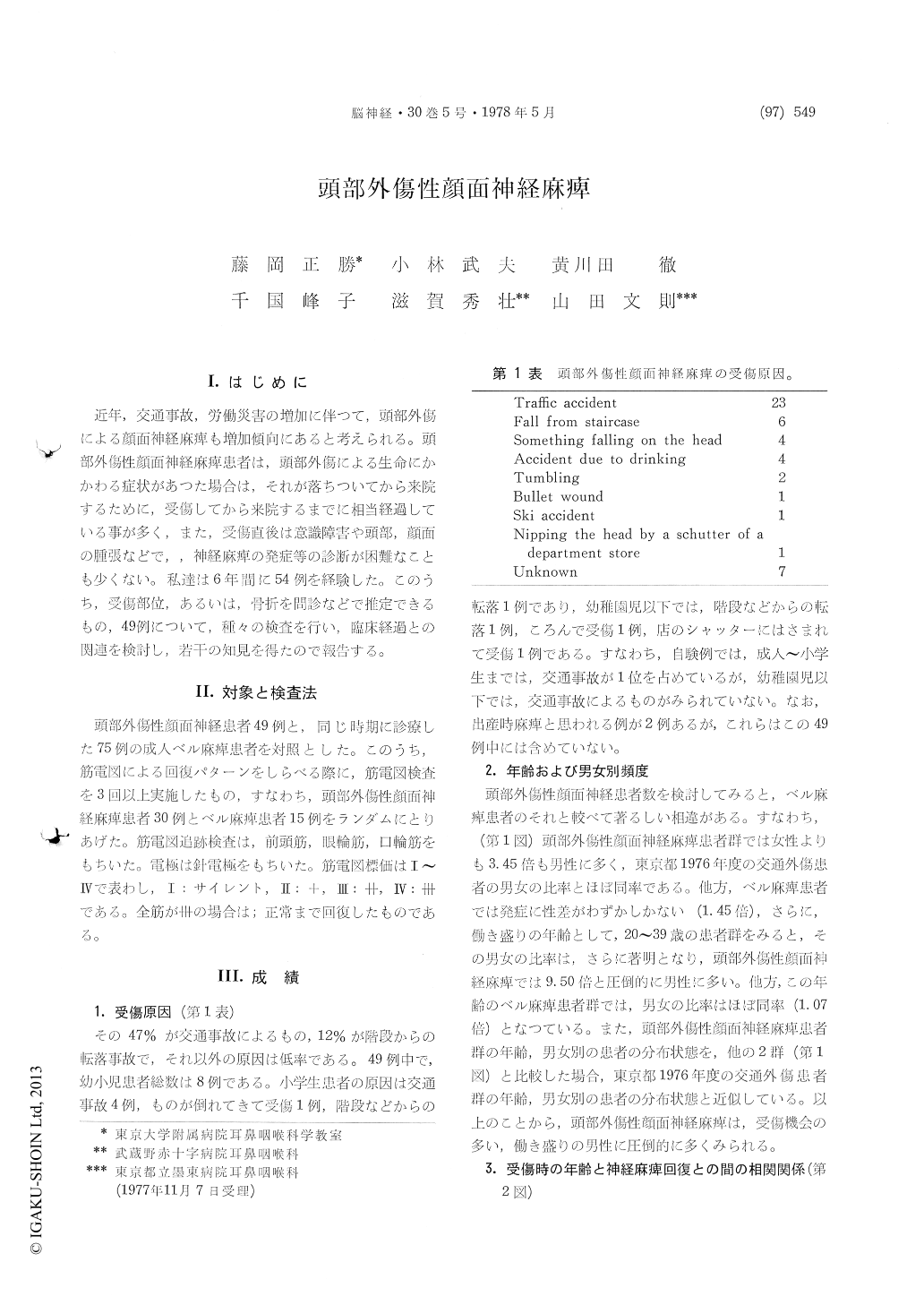Japanese
English
- 有料閲覧
- Abstract 文献概要
- 1ページ目 Look Inside
I.はじめに
近年,交通事故,労働災害の増加に伴つて,頭部外傷による顔面神経麻痺も増加傾向にあると考えられる。頭部外傷性顔面神経麻痺患者は,頭部外傷による生命にかかわる症状があつた場合は,それが落ちついてから来院するために,受傷してから来院するまでに相当経過している事が多く,また,受傷直後は意識障害や頭部,顔面の腫張などで,,神経麻痺の発症等の診断が困難なことも少くない。私達は6年間に54例を経験した。このうち,受傷部位,あるいは,骨折を問診などで推定できるもの,49例について,種々の検査を行い,臨床経過との関連を検討し,若干の知見を得たので報告する。
We examined 49 cases of traumatic facial palsy due to head injury, subject to in our hospital in 1970-1976. We also examined 75 cases of Bell's palsy, visited in our hospital in 1973-1976. From this study, we obtained the following results;
1) The traffic accidents with traumatic facial palsy are most frequently observed in patients from elementary-school pupils to adults. In patients up to preschool age, however, main causes of injury are accidents such as falling from staircase or stumbling but not traffic accidents.
2) In the traumatic facial palsy, male patients are observed by far more frequently than female patients for ages from 20 to 39, the former having more occasion of head injury. On the contrary, however, in Bell's palsy for the patients of the same ages, the occurance rate is almost equal for male and female.
3) In the traumatic facial palsy, there is observed no correlation between the recovery rate and the age of the patients.
4) Head injury with traumatic facial palsy isobserved most frequently in the temporal region, secondly in the facial or frontal region, and thirdly, in the occipital region.
5) Symptomes other than traumatic facial palsy, such as loss of consciousness and those of the ear such as hearing impairment or ear bleeding, are most frequently observed from injury of any part of the head regions described above.
6) From the 8 cases of our operation, we must but conclude that the lesion of the facial nerve inferred from the clinical symptomes does not always correspond to surgical findings.
7) In the recovery of EMG in the traumatic facial palsy, three types were seen in the lapse of time; the first type which is observed mostly in the group of onset of facial palsy within a week from the date of injury, and this type of facial palsy recovers in several months. It may be caused by reversible compression of the nerve (neurapraxia). Second type is observed mostly in the group of onset of facial palsy within a month and this type recovers in several months. It may be caused by axonotmesis. Last type is observed mostly in the group of onset within an hour and this type shows scarce recovery. It may be caused by axonotmesis. In Bell's palsy, no such types in the lapse of time are clearly observed.
8)"Indication for operation"was discussed. We consider surgical indication as follows; most of immediate traumatic facial palsy have good surgical indication, if there is no sign of recovery after several weeks. In the delayed traumatic facial palsy, because most of cases show gradual recovery after several weeks in EMG, it is not too late to perform surgical operation after 2-2.5 months. Macroscopic informations or dislocation of ossicles etc, are helpful in deciding surgical indication.

Copyright © 1978, Igaku-Shoin Ltd. All rights reserved.


